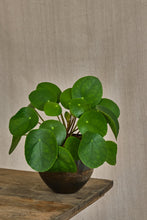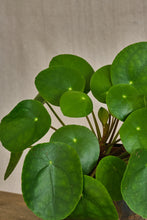Pot size: 13cm x Plant height: 20cm approx
Fits a pot with a 12cm - 14cm diameter.
*Pot in image not included in price
About
Pilea peperomioides, commonly known as the Chinese money plant or friendship plant, are a joy to have in the home. They have fleshy, lily pad shaped leaves at the end of long green stems which in maturity will create a thick canopy around the top and body of the main stem. This Pilea is known for producing lots of "pups" which are easily separated from the parent plant and make great gifts for friends (hence the common name).
Light: Bright but indirect
Pilea prefer a spot without direct light although they can handle a few hours in the early morning or late afternoon. Too much light can scorch the leaves but not enough light will make your pilea grow leggy towards the nearest light source. A North or East-facing window is ideal for this light loving houseplant.
Watering: Moderate
Being a tropical plant, Pilea don't enjoy long periods of drought. In Spring & Summer you want to make sure the top couple of inches of soil dry between waterings, and in Autumn & Winter at least half the pot of soil should be dry before you water again. The easiest way to check moisture levels is by sticking your finger into the soil to the required depth. If the leaves start to droop it’s usually a sign that your pilea needs a soak, and yellowing will indicate too much water.
Humidity: Moderate/High
Pilea are tropical and subtropical plants that will enjoy high levels of moisture in the air. However, they should still do well with the humidity levels in the average home environment. Browning on the edge of the leaves can be a sign that humidity levels are too low. If this occurs, spray the leaves with a water misting bottle or place a dish filled with stones and water beneath the plant.
Note:
Rotate your pilea regularly to ensure it grows upright and even.
As previously mentioned , Pilea are known for their production of pups. These "babies" (which are actually basal shoots grown from the roots) will appear during the growing seasons (Spring & Summer) and can be separated at the base of their roots where they connect with the parent plants using with a sharp tool such as a knife or scissors. Place the pup into a separate pot filled with a free draining compost that has been lightly moistened and watch your new plant flourish!




